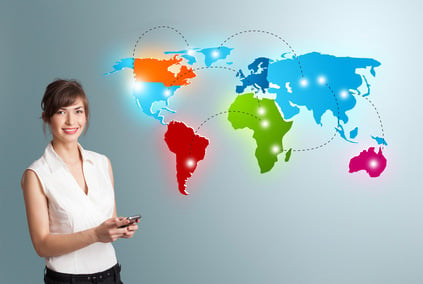
Many small and midsize companies in the U.S. deal with overseas clients and vendors every day. Meeting your international business contacts in person often provides the chance to strengthen business relationships. Such occasions also offer excellent opportunities to make presentations about your company, products or services. There are some steps you can take when presenting to an international audience to help ensure you'll be understood.
Many small and midsize companies in the U.S. deal with overseas clients and vendors every day. Meeting your international business contacts in person often provides the chance to strengthen business relationships. Such occasions also offer excellent opportunities to make presentations about your company, products or services.
You may find yourself conducting a product demonstration to one or two persons or presenting a company overview to a roomful of people. How will you communicate? You have options if you speak the local language fluently, but in most cases you will most likely communicate in English.
What if you are giving an industry update to a multinational audience at an overseas trade show? The odds are high that your audience will expect you to communicate in English, the primary language of international business. But not everyone in the audience may speak English fluently. As a result, they may misinterpret some of your message and key points if you don't modify how you present.
There are some steps you can take when presenting to an international audience to help ensure you'll be understood.
Adapt your communication style. The style of communication in the U.S. tends to be informal and direct. We immediately use first names and rarely use titles. This is not always the case elsewhere where formalities and titles play a role. It's easier to start off initial introductions more formally and switch to a less formal manner as the relationship develops.
A little use of the local language can go a long way. If your ability to converse in the local language is limited—or as is more often the case, non-existent—you can still learn a few words of greeting. This simple act can help promote smooth relationships, demonstrating your willingness to learn about their culture. Just be sure to practice your pronunciation ahead of time.
If you try speaking in the local language, keep your comments short. I remember listening to an American executive read his entire five minute speech written phonetically in the local language. He thought the audience would appreciate the gesture, but any goodwill he hoped to generate was soon replaced with frustration. It would have been better if he had made a brief greeting in the local language, and then switched back to speaking in English.
Speak clearly and slowly. Your goal is to be understood. Read the faces of your audience. Are they following your words? A slightly slower pace may help. Some listeners may speak English fluently, but others may not. You should gauge your audience's level of comprehension and proceed accordingly.
Outline each point you want to make. If you're going to highlight three benefits of your product, simply say, "There are three points to cover…" and then proceed to describe them.
Be descriptive. A picture is worth a thousand words. Slides with diagrams and pictures (and not just text) can help convey the points you want to make. Likewise, stories and analogies help in explaining technical or complex topics.
Avoid slang and clichés. There are many expressions we use every day that don't translate well, from "You betcha" to "Hold on a sec." So if you think your audience may not understand you, rephrase those statements to "I agree" and "Please wait." U.S. sports terms in particular are not always understood, so telling someone they need to "step up to the plate" may cause more bewilderment than initiative.
Simple terms work best. Keep in mind that those who speak English as a second or third language may be more likely to understand more commonly used English words such as "win" instead of "triumph" or "start" rather than "commence." So again, adjust accordingly.
Speak from the perspective of your audience. Temperatures, weights and time can all be measured differently. If you're explaining distances, include kilometers and miles or talk about driving time. Likewise, if talking about the weather, give the temperature in Fahrenheit and Celsius. Also in much of Latin America, North and South America are often considered one continent. Thus, anyone from that continent is an American. A way to avoid any confusion is to simply use the term U.S. or "the States" in lieu of American.
Use humor with care. You may have a hilarious joke to tell, but does it readily translate? A punch line isn' funny if it's not understood. That doesn't mean you should void humor. One effective approach is to poke fun at yourself. That way the audience can laugh along with you since everyone can relate to making a mistake.
Tips for Working with an Interpreter
If the audience doesn't speak much English and it's critical that your message be completely understand, hire an interpreter. Some points to keep in mind:
Select an interpreter with expertise in your area. Does your industry use its own jargon or involve complex technology? Interpreters often specialize in particular industries. Select one familiar with your type of business. Ask for references.
Share your talk with the interpreter ahead of time. If you have a prepared speech, let your interpreter read it beforehand. The interpreter can then ask you for clarification of industry-specific expressions in advance of your talk. For the same reason, provide interpreters with your product brochures and company profile ahead of time.
Remember that your talk has just doubled in length. Be prepared to break up your presentation into translatable chunks, pausing often to permit the interpreter time to translate to the audience. This often means your presentation will take twice as long to complete. Plan to either set aside more time or shorten your speech.
Communication is an essential part of any business undertaking, no matter where you are located. The key to successfully presenting to an international audience requires equal measures of preparation and adaptability.
About the U.S. Commercial Service
As the trade promotion unit of the U.S. Department of Commerce's International Trade Administration, the U.S. Commercial Service connects U.S. businesses with international buyers through a network of offices in 108 U.S. cities and U.S. Embassies and Consulates in more than 70 countries. Services include export counseling, market research, business matchmaking, participation in trade events, international partner searches, advocacy and more. For more information visit
www.export.gov.
International Sales & Marketing
 Francis Peters |
4 min. read
Francis Peters |
4 min. read



